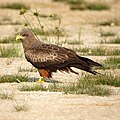Milvus
| Milvus | |
|---|---|

| |
| Black kite, (Milvus migrans migrans) | |
| Scientific classification | |
| Kingdom: | Animalia |
| Phylum: | Chordata |
| Class: | Aves |
| Order: | Accipitriformes |
| Family: | Accipitridae |
| Subfamily: | Milvinae |
| Genus: | Milvus Lacépède, 1799 |
| Species | |
|
See text for discussion | |
Milvus is a genus of medium-sized birds of prey. The genus was erected by the French naturalist Bernard Germain de Lacépède in 1799,[1] and named after the Latin word for the red kite.[2]
Species[]
This is an Old World group consisting of three kites that form part of the subfamily Milvinae. Its systematics are under revision; it contains 3 or 4 species.
| Image | Scientific name | Common Name | Distribution |
|---|---|---|---|
 |
Milvus milvus | Red kite | western Europe and northwest Africa, |
 |
Milvus migrans | Black kite | Eurasia and parts of Australasia and Oceania |
 |
Milvus aegyptius | Yellow-billed kite | sub-Saharan Africa (including Madagascar), except for the Congo Basin (with intra-African migrations) |
Allozyme data indicates that the genetic diversity in both black and red kites is rather low.[3] Successful hybridization between Milvus kites is fairly commonplace, making mtDNA analyses unreliable to resolve the genus' phylogeny. Furthermore, there is no good correlation between molecular characters and biogeography and morphology in the red kite due to very incomplete lineage sorting.
The yellow-billed kite is apparently a separate species, as indicated by mtDNA phylogeny showing two supported clades,[4] biogeography,[5] and morphology.[5] The black-eared kite is somewhat distinct morphologically, but is better considered a well-marked parapatric subspecies. The status of the Cape Verde kite is in doubt; while not a completely monophyletic lineage according to mtDNA data,[4] it is still best regarded as a distinct species. Whatever its status, this population is extinct.
A prehistoric kite from the Early Pleistocene (1.8 million–780,000 years ago) deposits at Ubeidiya (Israel) was described as Milvus pygmaeus.
References[]
| Wikispecies has information related to Milvus. |
- ^ Lacépède, Bernard Germain de (1799). "Tableau des sous-classes, divisions, sous-division, ordres et genres des oiseux". Discours d'ouverture et de clôture du cours d'histoire naturelle (in French). Paris: Plassan. p. 4. Page numbering starts at one for each of the three sections.
- ^ Jobling, James A. (2010). The Helm Dictionary of Scientific Bird Names. London: Christopher Helm. p. 255. ISBN 978-1-4081-2501-4.
- ^ Schreiber, Arnd; Stubbe, Michael & Stubbe, Annegret (2000): Red kite (Milvus milvus) and black kite (M. migrans): minute genetic interspecies distance of two raptors breeding in a mixed community (Falconiformes: Accipitridae). Biol. J. Linn. Soc. 69'(3): 351–365. doi:10.1006/bijl.1999.0365 (HTML abstract)
- ^ Jump up to: a b Johnson, Jeff A.; Rick T. Watson, and David P. Mindell (7 July 2005). Prioritizing species conservation: does the Cape Verde kite exist?. Proc Biol Sci. (The Royal Society) 272 (7): 1365–1371. [1]
- ^ Jump up to: a b Scheider, Jessica; Wink, Michael; Stubbe, Michael; Hille, Sabine; Wiltschko, Wolfgang (2004). "Phylogeographic Relationships of the Black Kite Milvus migrans" (PDF). In Chancellor, R. D.; Meyburg, B.-U. (eds.). Raptors Worldwide: Proceedings of the VI World Conference on Birds of Prey and Owls. Budapest, Hungary: MME/BirdLife Hungary. pp. 467–472. ISBN 978-963-86418-1-6.
- Crochet, Pierre-André (2005): Recent DNA studies of kites. Birding World 18(12): 486–488. HTML section list
| Wikimedia Commons has media related to Milvus. |
- Milvus
- Bird genera
- Kites (birds)
- Accipitriformes stubs
